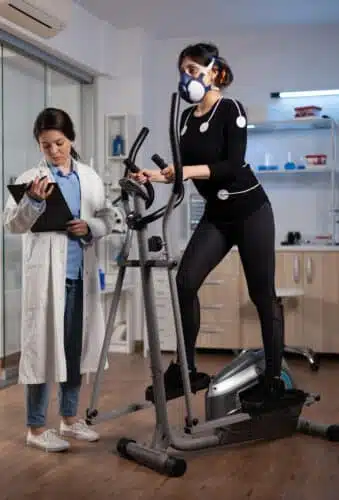Copyright © 2025 Open Medicine Foundation. All Rights Reserved.
This study explores the biological changes that occur in the muscles during post-exertional malaise (PEM), both in historical cases of ME/CFS and cases of Long COVID that meet the criteria for ME/CFS.
The hallmark symptom of ME/CFS is the flu-like worsening of symptoms after physical, mental, or emotional exertion. This is known as post-exertional malaise (PEM).
Dysfunction of the mitochondria has demonstrated decreased ability to use oxygen during exercise and possible interference in energy production. The researchers will investigate mitochondrial dysfunction during PEM in a biopsy of the vastus lateralis, one of the four major muscles in the anterior thigh. The impact of PEM on ventilatory and pulmonary gas exchange measures will also be assessed.
Specifically, the team will look at changes in how the patients utilize oxygen, their achieved workload, and how efficiently they respired at peak exercise and at the ventilatory threshold. (The ventilatory threshold is also known as the point at which the body becomes more dependent on acquiring energy from mechanisms not involving oxygen.)
With this data, the researchers will compare measures within and between groups to demonstrate the effect of PEM in ME/CFS patients due to exertion.

OMF is a non-profit 501(c)(3) organization
(EIN# 26-4712664). All donations are tax-deductible to the extent allowed by law.



Open Medicine Foundation®
29302 Laro Drive, Agoura Hills, CA 91301 USA
Phone: 650-242-8669
info@omf.ngo
Copyright © 2025 Open Medicine Foundation. All Rights Reserved.
What are the advantages of giving from your Donor Advised Fund (DAF)?
How do I make a donation through my DAF?
Just click on the DAF widget below. It is simple and convenient to find your fund among the over 900 funds in our system.
Still can’t find your fund?
Gifting of Stock
Broker: Schwab
DTC #: 0164
Account #: 47083887
Account Registered as:
Open Medicine Foundation
29302 Laro Drive
Agoura Hills, CA 91301
Please speak to your personal tax advisor and then email or call OMF at 650-242-8669 to notify us of your donation or with any questions.